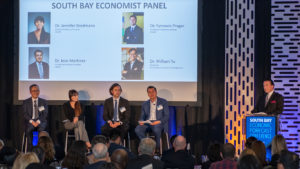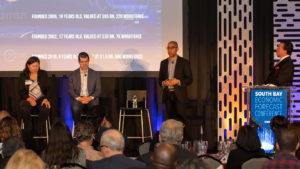
After years of solid economic growth, the South Bay’s local economy will experience some slowing in 2020, but will remain stable due in part to the federal government’s high level of defense spending in the region.
Such was one of the many economic projections presented in the 2019 South Bay Economic Forecast and Industry Outlook, which California State University, Dominguez Hills (CSUDH) released on Oct. 29 as part of the fifth annual South Bay Economic Forecast conference hosted on campus. Approximately 200 guests representing cities and businesses throughout the region attended.
CSUDH developed the report and the conference to provide a focused look at the current state of the region’s economy and forecast for the coming year. This year’s conference, titled “A Region in Transition: Advances in Innovative Technology,” was organized into two panel discussions focused on the regional economy and local businesses, with participants fielding questions about their research, services, and industries from host Frank Mottek, anchor for KNX 1070 NEWSRADIO.
Economic Panel: South Bay Economic Forecast Report

The economic panel included UCLA Anderson Forecast Economist William Yu, and CSUDH faculty members: Assistant Professor of Finance Jennifer Brodmann, Assistant Professor of Public Administration Fynnwin Prager, and Professor of Economics Jose Martinez. The professors conduct much of their research through CSUDH’s South Bay Economics Institute.
CSUDH partners with Yu and the UCLA Anderson Forecast to produce the annual economic forecast report.
“As the southern part of Silicon Beach, South Bay’s economy grew at a steady pace in 2018-19. With its high productivity and wages, technology jobs are the pillar of the region’s economy,” said Yu. “We predict that South Bay’s growth rate will slow down over the next year, mostly due to the slowing of the U.S. and global economies, while SpaceX and the local aerospace industry will continue their pursuits in space expedition.”
According to the economic report, the South Bay employed approximately 452,000 individuals in the private sector during the third quarter of 2018, representing nearly one-tenth of the L.A. County’s workforce.
The report shows that at $62,300, the average annual wage of a worker in the South Bay was slightly higher over the past year, and remained higher than wages throughout Los Angeles County, due to the fact that many jobs in the South Bay require more human capital and skills than work available throughout the rest of the county.
South Bay Wages by Sector
Manufacturing: $1.48 billion
Scientific and technical services: $820 million
Health care and social services: $610 million
Wholesale trade: $500 million
Transportation and warehousing: $430 million
The three sectors with the highest salaries in 2018 were the information industry, with an average salary of $111,000, finance, with an average close to $108,000, followed by the professional, scientific, and technical services industries, with an average salary of $103,000.
Martinez’s research on the South Bay housing market found a modest increase in prices during 2018-2019, and predicted that the region will continue to see a similar increase in 2019-2020. Recent home sales in the South Bay have been helped by declines in mortgage rates, and rates are not predicted to drop much further.
Martinez believes that the potential for a recession due to the housing market is “not likely.” “The relaxation of lending practices that we saw in the previous crisis and subsequent recession has not returned,” Martinez said. “At the same time, speculative investing in housing is relatively mild, so we might be able to say that housing will not cause another mortgage crisis and subsequent recession, at least not in the short run.”

Brodmann, whose research includes entrepreneurial trends, found that company startup activity is primarily concentrated in four cities in the South Bay: El Segundo, Hawthorne, Torrance, and Inglewood. The main industries obtaining startup funding in the South Bay are aerospace and defense, Internet, mobile and software services, e-commerce, food and beverage, and pharmaceuticals.
“With all of this growth in entrepreneurship in the South Bay, there are still means of continuing improvement, such as increasing growth in women and minority entrepreneurships, which face barriers in accessing startup resources and capital,” Brodmann said.
Prager shared his research on flexible workplace practices, where he has found that trends in the adoption of alternative workplace practices, particularly working from home, are not increasing as much as expected across the region.
He also reported on the growth of Blockchain transactions. “Blockchain could displace or increase competition for numerous occupations in the South Bay, especially those currently involved in the verification of contracts and supply chain operations, trade brokerage, data management and processing, and accounting systems management,” he said.
Technology Panel
During the technology panel, representatives from regional technology, automotive, and aerospace companies shared the latest advancements in electronic mobility technology and business models, aerospace innovations in rocket-to-space delivery, and support for aerospace startup companies.

The panelists included Monica Jan, senior director of strategy and customer experience of Virgin Orbit; Phillip Weicker, energy storage and conversion innovator for Canoo, a Los Angeles-based company developing a subscription-only electric vehicle membership program; and Van Espahbodi, co-founder, manager, and partner of Starburst Accelerator. Starburst Accelerator provides startups with mentoring and access to aerospace and aviation stakeholders, and connects aerospace and defense leaders with innovative startups worldwide.
The panelists were asked a variety of questions about their companies’ technology and products, and to share their thoughts about the economic outlook for their industries.
“We’re always hiring. The U.S. Department of Defense (DOD) and the national security apparatus is very intrigued by what’s happening in the commercial sector, and on the space front in particular,” said Espahbodi. “The DOD will continue to tap into the sector for what they call ‘rapid acquisition.’ I see the future for us as being very bright.”
Jan also predicts continued growth in the private U.S. aerospace sector over the next five years, and sees similar developments internationally. “I track the space economy closely and we’re still seeing growth and investment coming in,” she said. “I’m seeing an accelerated pace of capital being deployed in international governments, which are starting to pay attention to the potential for their own space programs.”
Weicker is optimistic about his company’s business model and the progression of the electric vehicle industry. “Business has been generally robust, even with the economic slowdown that we’ve seen in the last 20 months that Canoo has been in existence,” said Weicker. “In terms of perceived volatility, people still believe that they have a lot of options in our industry.
Watch the entire 2019 South Bay Economic Forecast Conference below.